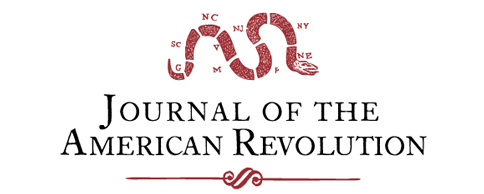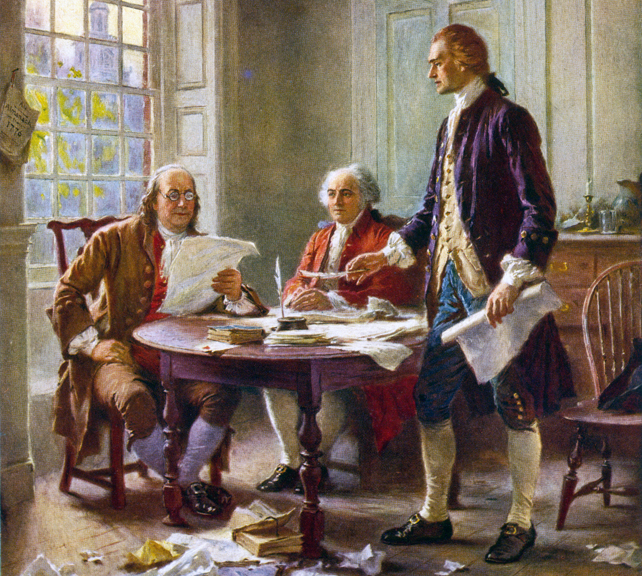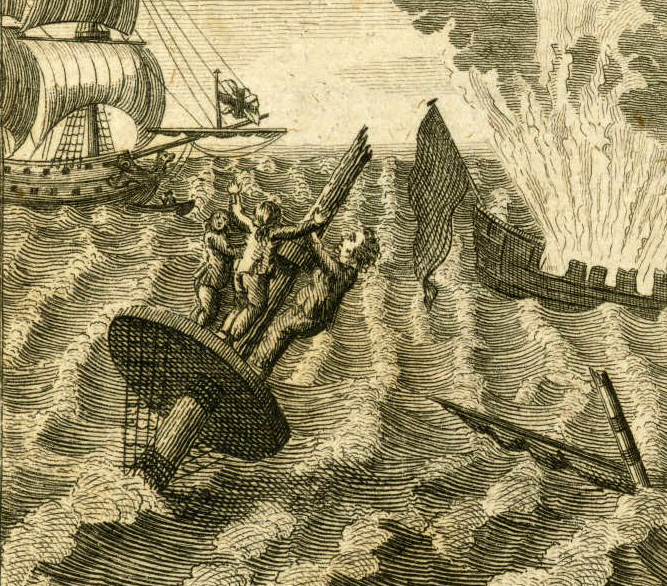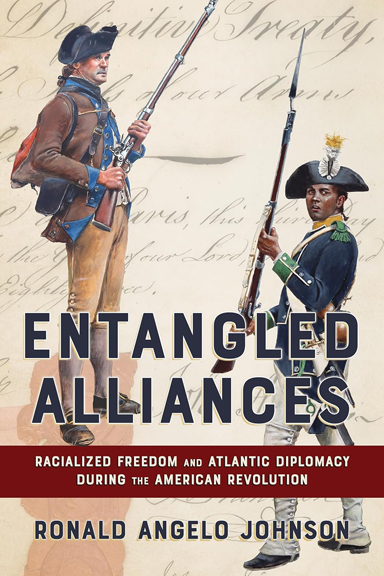This month we asked our contributors to tell us about an artifact from the 1765-1805 era known to have existed well into the nineteenth century, that has since been stolen or gone missing.
J.L. Bell
In the mid-1800s James Ward Hall of Cavendish, Vermont, told Henry B. Atherton about a “military cap with its three ostrich feathers” that his father, James Hall, had worn on April 19, 1775. “John Gray of Westford [Massachusetts] pulled off” the cap “and subsequently gave [it] to his daughters.” Neither the cap nor the Gray family can be traced. Which is a shame because, according to his son and corroborating sources, James Hall was a light infantryman in the 4th Regiment of Foot who pretended to be wounded in order to defect to the provincials.
Todd W. Braisted
One of the most striking portraits of a Loyalist officer was that of Lieutenant James Moody of the 1st Battalion, New Jersey Volunteers. After the war Moody, as a half-pay officer, settled in Nova Scotia to start a new life. He settled in Weymouth, where he eventually donated land for an Anglican church to be built in 1790. During a visit to England in 1782-1783, Moody had his portrait, in uniform, painted. This painting passed through his family until 1979, when his descendant, John Moody, donated the painting to the church in Weymouth, which he and his wife thought a fitting place for it. It hung for two years at St. Peter’s in Weymouth until the night of a wedding there, and then disappeared. It has not been since 1981. A replica portrait, based on photographs, hangs in its place.
Robert Wright
Nobody knows what has become of the account books of the Bank of the United States (1791-1811). There are theories but no clear evidence. Several researchers including myself have scoured sub-basements in old Philadelphia buildings and the archives in Harrisburg without success. By contrast, an almost complete set of the records of its predecessor, the Bank of North America, are available at the Historical Society of Pennsylvania.
Robert N. Fanelli
The memoir of founding father Elias Boudinot, American Commissary of Prisoners during the Revolution, appears to be lost. Boudinot’s manuscript “Reminiscences” found its way into the hands of noted numismatist and collector, Joseph J. Mickley, of Philadelphia, and was transcribed and published, in whole or part, three times. In 1878, the document was featured prominently in Mickley’s estate sale catalogue. By 1896, it was owned by book collector, John Nicholas Brown, and was in possession of the John Carter Brown Library in 1952, but is no longer accessible. Miscatalogued, stolen or deaccessioned? No one seems to know.
John U. Rees
My favorite artifact survived the war but likely no longer exists. In July 1820, at the behest of the War Department, Artillo Freeman submitted a tally of his belongings. With no real estate or fixed income, Freeman noted, “he has no Trade, but Picks Oakum for a living when he is able to work.” Mr Freeman”s possessions included “Bed & Beddings,” “4 Chairs,” “Crockery,” “Pots Kettles pans,” “1 Coat,” “3 shirts,” “1 Chest & Trunk,” his “Wife & Childs Clothes,” a small quantity of personal apparel, and “1 Pig,” in total worth $15.75. At the end of the list he added one more item, “Revolutionary Uniform – Invaluable.”
Victor J. DiSanto
Fidelity Medallions (also known as the Andre Capture Medallion) were authorized by Congress in 1780 and awarded to Isaac Van Wart, David Williams, and John Paulding by George Washington at Verplank’s Point in 1782. Acknowledged as the old military decoration in United States history, they are also significant because the three recipients were enlisted men. Van Wart’s Fidelity medallion is in the collection of the New York State Museum. Williams’ and Paulding’s medallions were stolen from the New York Historical Society in 1976.
Stuart Lyall Manson
The surrender of British General John Burgoyne at Saratoga in 1777 included his artillery. The victorious Americans subsequently had several engraved with a statement that they were witnesses to that monumental event. They nevertheless continued to serve in the defence of the Republic for decades. During the War of 1812, two of these engraved cannons were recaptured by British and Canadians at the fall of Ogdensburg, New York in 1813. Said to be long iron 12-pounders—although more likely made of bronze—they do not appear to be among those catalogued by Douglas Cubbison in his book “The Artillery Never Gained More Honour.” The cannons’ whereabouts are currently unknown.
Robert J. Guy
In 1870, Delaware attorney William Thompson Read wrote about the silver metal his grandfather received for his participation in the battle of Kittanning in 1756. “I have before me General Thompson’s metal . . . given to me by my mother because I was named after him. It is blackened by time.” One of the first commemorative medals ever struck in America, only a handful of these original silver medals remain. Eventually donated to the Historical Society of Pennsylvania, Thompson’s medal was on display at the Western Pennsylvania Numismatic Society in Pittsburgh in 1963. Despite an ongoing FBI search, it remains missing.
Adam Zielinski
While “artifact” may be a bit disrespectful, the remains of Hessian Colonel Carl Emil von Donop were said to have been stolen from his grave near Fort Mercer sometime in the mid-nineteenth century by relic hunters. Dying three days after the Battle of Red Bank, he was buried about 100 feet from the Whitall House; his stone marker simply read, “Here lies Count Donop.” Treasure hunters continued chipping away at the stone throughout the nineteenth century, and several stories relayed in Philadelphia/New Jersey newspapers stated his bones were dug up and scattered about. The whereabouts of his skull spurred many editorials. Today, the former site is thought to be submerged under the Delaware River. Surely, the fallen colonel deserved better.








5 Comments
As described in New Jersey State Museum Bicentennial catalog of know Revolutionary War artifacts, “The Pulse of the People: New Jersey 1763-1789,” #240. Hunting Sword ca.1750 England; silver-mounted hunting sword with black leather scabbard; grip of ivory, stained green, with lion’s head pommel; 30 3/4 in. Monmouth County Historical Association. This sword was carried by militia Captain James Bruere (1751-1807), who fought a the battle of Monmouth. Bruere was from Allentown, New Jersey and is buried in the graveyard of the Presbyterian church there. Loaned to Fort Monmouth before its closing, it was never returned. Efforts by the Historical Association and former Fort Monmouth historian, Melissa Ziobro, to recover this artifact have been in vain.
Does anybody know who has it?
No, neither former Fort Monmouth officials nor Monmouth County Historical Association staff know where it is located. Hopefully it will be found before the 250th anniversary of the Battle of Monmouth in 2028.
Re Von. Donop, see footnote three and the link in my August 2018 JAR article “a visit to old Fort Mercer on the Delaware“
Elias Boudinot Manuscript: Good news! The John Carter Brown Library at Brown University has located Elias Boudinot’s reminiscences in its collection. The manuscript is titled “A Magazine for Miscellanious Pieces & Publications collected & preserved by Elias Boudinot from 1775” . The catalog number is Codex Eng 82. While the earlier published versions cover much of its contents, the manuscript volume is unique. Thanks to Karin Wulf, Mark Armstrong and Kimberly Nusco at the Library for turning up and making available this important contribution to our knowledge of the American Revolution.